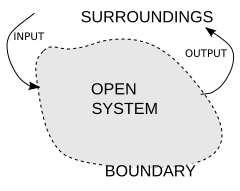Systems thinking facts for kids
Systems thinking is a special way of understanding the world around us. Instead of looking at small pieces separately, it helps us see how everything is connected and works together as a whole. It's like looking at a bicycle: you don't just see the wheels, pedals, and chain, but how they all work together to make the bike move. This way of thinking helps us solve problems and make changes in complicated situations. It's connected to ideas from systems theory and system sciences.
Contents
History of Systems Thinking
Early Ideas of Systems
The word "system" has been used in many ways for a long time. For example, in 1674, Robert Hooke talked about the "System of the World." This meant how planets and stars were arranged. People used to think the Earth was the center (the Ptolemaic system). Later, Nicolaus Copernicus showed that the Sun was the center (the Copernican system).
Isaac Newton later explained this "System of the World" in detail in 1687. He used math to describe how planets move. His ideas about how things move and interact are still used today to understand "dynamical systems."
Controlling Systems with Feedback

Imagine you want to keep something at a certain temperature or speed. In 1868, James Clerk Maxwell studied how to control the speed of machines. He looked at how a machine could use its own output to adjust itself. This is called "feedback." A good example is a James Watt's (1784) steam engine part that helped keep the engine's speed steady.
Maxwell's work made it easier to solve problems with moving systems. Later, during World War II, Norbert Wiener used these ideas to develop cybernetics, which is the study of control and communication in animals and machines.
The Bell System: A Huge Network
In 1876, Alexander Graham Bell invented the telephone. He then started the Bell Telephone company. A big idea for this company was "universal service," meaning everyone should have telephone service. This led to building a massive network of communication systems across the whole country.
Sending messages reliably over long distances was a huge challenge. It took many years and new technologies to make it work. Scientists at Bell Laboratories, like Harry Nyquist and Claude Shannon, figured out how to send voices clearly. They discovered that you need to sample sound at least 8,000 times per second for good phone calls.
Bell Laboratories also invented the bipolar junction transistor in 1948, which was a big step towards modern integrated circuits (computer chips). They even discovered the cosmic microwave background, which helped us understand the Big Bang!
How Systems Thinking Is Used
Systems thinking helps us understand how to make changes in complex systems. For example, if you want to improve a school, you don't just change one rule. You look at how students, teachers, parents, and the community all interact. Small changes in the right places can lead to big improvements. This is called finding "leverage points" in a system.
What Makes a System?
A system is a group of things that are connected and work together to create a certain pattern of behavior over time. Think of a sports team: the players, coach, and rules are all connected. Their interactions create the team's playing style. A system's response to outside forces is unique to itself and often complex.
- Subsystems: These are smaller systems that are part of a larger system. For example, your digestive system is a subsystem of your body. Each subsystem can be studied on its own, but it also affects the larger system.
- Black Boxes: Sometimes, we don't need to know every tiny detail about how a part of a system works. We just need to know what goes in (input) and what comes out (output). This is like a "black box" – you know what it does, but not exactly how it does it inside.
Here are some examples of different types of systems:
- Political Systems: How governments are organized and make decisions.
- Biological Systems: Like the human body, where different organs work together.
- Economic Systems: How money, goods, and services are produced and exchanged.
- Social Systems: How people interact in groups, like a community or a family.
- Radar Systems: Used during World War II to detect airplanes. They had different parts like transmitters and receivers working together.
- Dynamical Systems: Systems that change over time, like the weather or the movement of a pendulum. Scientists use math to predict their behavior.
- Thermodynamic Systems: Systems that deal with heat and energy, like an engine. Scientists learned that energy can be changed but not created or destroyed in a closed system.
Systems That Are Always Changing
Living things are "far from equilibrium," meaning they are always active and changing, not still and balanced like a rock.
- Resilience: Living systems are strong and can bounce back from problems. They are "resilient."
- Homeostasis: This is like a living system's way of staying balanced. Your body uses homeostasis to keep your temperature and blood sugar steady.
- Self-organization: Resilient systems can organize themselves without someone telling them exactly what to do. Think of how a flock of birds flies together without a leader.
- Hierarchy: In resilient systems, different levels of control exist. For example, your brain controls your body, but smaller parts like your heart have their own controls too.
Tools for Systems Thinking
There are many ways to use systems thinking to understand and solve problems:
- Critical Systems Heuristics: This helps you think about different viewpoints and what's important when looking at a system.
- Critical Systems Thinking: A broader approach that includes different ways of thinking about systems, like the EPIC approach.
- Ontology Engineering: This is about clearly defining and naming the parts of a system and how they relate to each other.
- Soft Systems Methodology: This helps you understand messy, human-related problems by looking at different viewpoints, like the CATWOE approach.
- Systemic Design: This uses systems thinking to create new solutions, often using a "double diamond" process to explore and develop ideas.
- System Dynamics: This helps you understand how things change over time in a system, looking at how things flow and how feedback loops work.
- Viable System Model: This model helps understand how organizations can be successful and survive by looking at five key parts that manage different functions.
See also
 In Spanish: Pensamiento sistémico para niños
In Spanish: Pensamiento sistémico para niños
- Systems Engineering
- Management cybernetics
- Operational research




